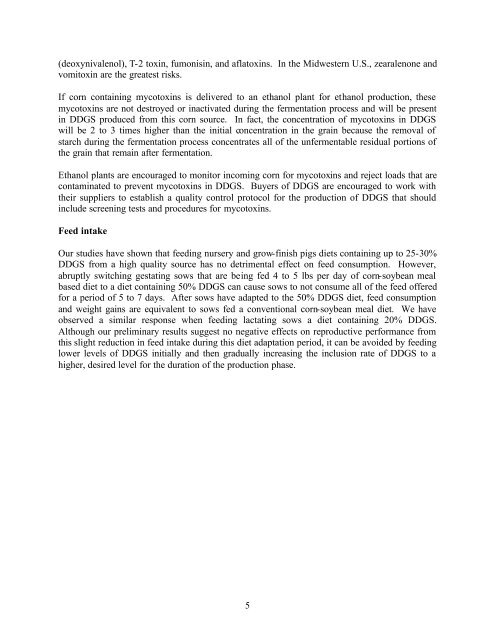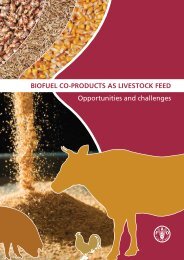Distillers Grains Feeding Recommendations. - Distillers Grains By ...
Distillers Grains Feeding Recommendations. - Distillers Grains By ...
Distillers Grains Feeding Recommendations. - Distillers Grains By ...
You also want an ePaper? Increase the reach of your titles
YUMPU automatically turns print PDFs into web optimized ePapers that Google loves.
(deoxynivalenol), T-2 toxin, fumonisin, and aflatoxins. In the Midwestern U.S., zearalenone andvomitoxin are the greatest risks.If corn containing mycotoxins is delivered to an ethanol plant for ethanol production, thesemycotoxins are not destroyed or inactivated during the fermentation process and will be presentin DDGS produced from this corn source. In fact, the concentration of mycotoxins in DDGSwill be 2 to 3 times higher than the initial concentration in the grain because the removal ofstarch during the fermentation process concentrates all of the unfermentable residual portions ofthe grain that remain after fermentation.Ethanol plants are encouraged to monitor incoming corn for mycotoxins and reject loads that arecontaminated to prevent mycotoxins in DDGS. Buyers of DDGS are encouraged to work withtheir suppliers to establish a quality control protocol for the production of DDGS that shouldinclude screening tests and procedures for mycotoxins.Feed intakeOur studies have shown that feeding nursery and grow-finish pigs diets containing up to 25-30%DDGS from a high quality source has no detrimental effect on feed consumption. However,abruptly switching gestating sows that are being fed 4 to 5 lbs per day of corn-soybean mealbased diet to a diet containing 50% DDGS can cause sows to not consume all of the feed offeredfor a period of 5 to 7 days. After sows have adapted to the 50% DDGS diet, feed consumptionand weight gains are equivalent to sows fed a conventional corn-soybean meal diet. We haveobserved a similar response when feeding lactating sows a diet containing 20% DDGS.Although our preliminary results suggest no negative effects on reproductive performance fromthis slight reduction in feed intake during this diet adaptation period, it can be avoided by feedinglower levels of DDGS initially and then gradually increasing the inclusion rate of DDGS to ahigher, desired level for the duration of the production phase.5
















